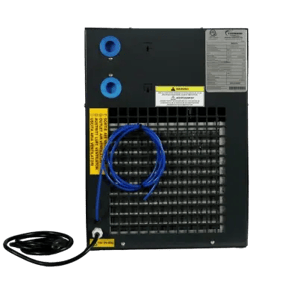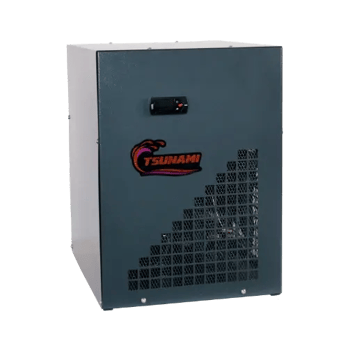3 min read
Cycling vs Non-Cycling Refrigerated Air Dryers: What's the Difference?
Tsunami Team
:
Nov 7, 2025 9:00:00 AM

Moisture in the air is every manufacturer's worst nightmare.
Clean, dry air is critical to manufacturers, especially in the automotive, food, pharmaceutical, and electronics industries. It prevents equipment damage from corrosion, prevents clogs, and ensures quality production with no interference from contaminants.
Refrigerated air dryers come to the rescue, removing moisture from compressed air to protect your system. They come in two forms – cycling and non-cycling. Both offer key advantages, so choosing which one is best for your operation depends on your particular requirements.
In this article, we’ll touch on what a refrigerated air dryer is, compare key features of both types, and offer tips on which is right for your workspace.
What is a Refrigerated Dryer?
Refrigerated air dryers work in the same way as a dehumidifier. Warm air can hold more moisture than cold air. Warm air, filled with moisture, enters the dryer that contains the refrigerated system. As the air cools, moisture is released in the form of water droplets and removed from the system. The air is reheated and then exits the refrigerated air dryer, ready for use. 
Refrigerated air dryers are a shop essential. Air contaminants can wreak havoc on pneumatic equipment, impacting the performance, lifespan, and maintenance. Dryers ensure your machines run smoothly and produce high-quality products.
Cycling vs Non-Cycling Refrigerated Air Dryers: At a Glance
There are two main refrigerated air dryer types: cycling and non-cycling. Cycling air dryers adjust according to the demand for dry air. The refrigeration system powers on and off as needed during the application. Non-cycling air dryers operate continuously, unless powered down.
The table below highlights the key differences between the two primary types.
| Non-Cycling Dryer | Cycling Dryer | |
|---|---|---|
|
Operation
|
Runs continuously
|
Adjusts based on demand
|
|
Energy Efficiency
|
Lower
|
Higher
|
|
Cost
|
Lower up-front
|
Higher up-front, lower operating
|
|
Maintenance
|
Simple
|
Slightly more complex
|
|
Dew Point Stability
|
Very stable
|
Slight variable
|
|
Dew Point Stability
|
Constant air demand
|
Variable air demand
|
Cycling Refrigerated Air Dryer
Cycling refrigerated air dryers are also known as demand-based or load-responsive air dryers. As this suggests, the refrigeration system of these dryers powers on and off as needed. They use thermal mass or variable speed to adjust the dryers' refrigeration system activity.
The dew point is able to fluctuate during applications with varying air demand. These dryers are best during operations with fluctuating air usage or productions that need to be more aware of energy use. Cycling refrigerated air dryers are often found in larger production sites with a CFM (cubic feet per minute) of 100 or more. They’re great for ensuring containers for packaging are free of contaminants and moisture in food production plants.
Key Takeaways:
- Main difference #1: Higher up-front cost. With a more complex operating system, cycling refrigerated air dryers are more expensive at purchase.
- Main difference #2: Energy efficient. Because the refrigeration system clicks on and off as needed, these dryers don’t use as much energy.
Non-Cycling Refrigerated Air Dryer
Non-cycling air dryers are also known as constant-speed or fixed air dryers because the refrigeration system continuously runs at full capacity, no matter what. While these dryers do consume more energy, they’re easier to operate, highly reliable, and less likely to cause production interruptions, all while maintaining a consistent dew point.
Non-cycling air dryers are best for applications with consistent airflow demand, such as spray foam. You can spray as much as you need with the system running continuously; but turn the equipment off when not in use. 
Key Takeaways:
- Main difference #1: Maintenance. Non-cycling air dryers are simple in design, making upkeep more streamlined and simpler.
- Main difference #2: Non-cycling air dryers have a lower up-front cost compared to cycling dryers
Cycling vs Non-Cycling Refrigerated Air Dryers: Choosing One for Your Application
Both types of refrigerated air dryers offer benefits. When deciding which works best for your facility and operation, consider these key factors:
- Air demand: Consider whether your system requires a continuously running refrigeration cycle or if intermittent operation is sufficient. Also, is a consistent dew point critical in your production?
- Energy use: What’s your facility’s priority and capacity around energy use? What level of energy use can your facility support?
- Budget: What’s your short and long-term budget? Dryer types have varying prices, as well as operating and maintenance costs.
- Facility: How big is your facility and operation? Which dryer offers the best performance and cost-efficiency for the size and layout of your facility?
Explore Your Refrigerated Air Dryer Options 
Choosing the best refrigerated air dryer for your facility involves many factors – more than just the air system’s needs. You’ll want to weigh the up-front costs versus operating and maintenance costs over time, as well as consider how the size of your space will impact the air dryer’s performance.
For more information on refrigerated air dryers, take a closer look at Tsunami's refrigerated dryers to see how they deliver reliable moisture control and energy efficiency.

